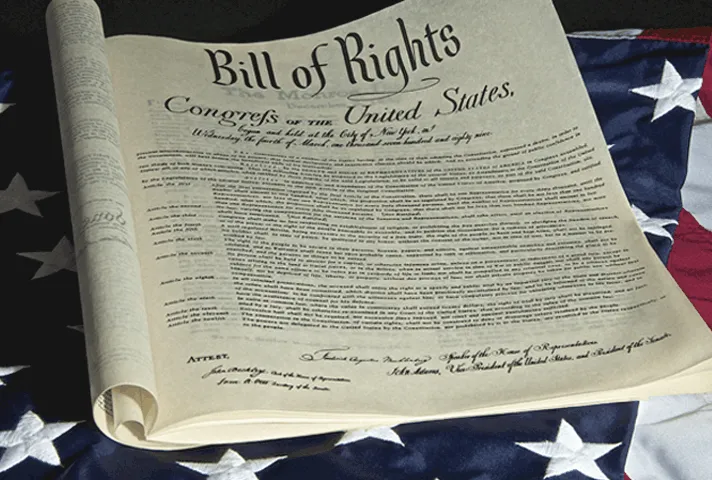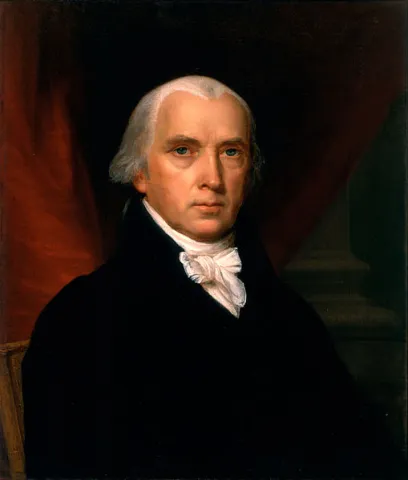
The Bill of Rights is among our nation’s most admired documents, guaranteeing broad personal liberties and inspiring some of the federal courts’ most famous and polarizing cases. And yet for well over a century, the Bill of Rights was one of America’s best kept secrets.
Ratified on Dec. 15, 1791, a day now celebrated annually as Bill of Rights Day, the first 10 Amendments to the U.S. Constitution were a response to broad public fears that a new national government might run roughshod over individuals and states.

James Madison drafted the Bill of Rights in 1789, to calm public fears about the U.S. Constitution, but courts largely ignored it until the 1920s.
On paper, the amendments protected such diverse rights as freedom of speech and religion, the right to bear arms, the right to a speedy trial by jury, and freedom from unreasonable searches. In modern times, Bill of Rights cases have expanded the right to counsel (Gideon v. Wainwright, Sixth Amendment), broadened protection against self-incrimination (Miranda v. Arizona, Fifth Amendment), redefined the right to bear arms (District of Columbia v. Heller, Second Amendment), and upended political spending restrictions (Citizens United v. FEC, First Amendment).
None of this seemed likely in our nation’s early history. Once the Bill of Rights was ratified, it virtually sat on a shelf for 130 years.
“For the first century of its existence, the Bill of Rights did not appear in many Supreme Court cases, principally because the Court ruled that it only applied to the national government, and the state governments exercised the most power over citizens’ lives,” said Linda Monk, author of “The Bill of Rights: A User’s Guide.”
In 1833, a Baltimore wharf owner asked the Supreme Court to extend the Bill of Rights to state and local governments, arguing that the city had violated his Fifth Amendment right to due process. The appeal met with a loud legal thud.
The Bill of Rights amendments “contain no expression indicating an intention to apply them to the State governments,” Chief Justice John Marshall wrote in Barron v. Baltimore. “This court cannot so apply them.”
Shortly after the Civil War, the newly ratified 14th Amendment appeared to require that states honor constitutional liberties, by declaring that “No State shall make or enforce any law which shall abridge the privileges or immunities of citizens of the United States.” The Supreme Court again ruled that the Bill of Rights did not apply to states.
Legal advocates began leveraging the Bill of Rights in the 1920s, and it gradually took on the central role we recognize today.
In 1925, the Supreme Court reversed direction, ruling that under the 14th Amendment, state governments must respect the First Amendment’s guarantee of freedom of speech.
Case by case, federal courts—first in a trickle and then in a flood—expanded the Bill of Rights’ reach. Under the doctrine of “incorporation,” Supreme Court decisions incorporated many Bill of Rights guarantees into the 14th Amendment, applying them to state and local governments. Some rights, such as the Third Amendment ban on military commandeering of civilian homes in peacetime, still have not been extended to all 50 states.
Today, Bill of Rights claims make up many of the highest-profile cases in each year’s Supreme Court docket.
“The freedoms expressed in the Bill of Rights express Americans’ most fundamental values: religion, speech, press, bearing arms, privacy, and the balance of power between the state and federal governments,” said Monk, who is appearing in a Bill of Rights Day panel hosted by the National Archives. “When we disagree strongly about the rights most precious to us, there is little ground for compromise.”
Even if the Bill of Rights lay dormant for more than a century, it is fitting that the public cares so deeply about rights-related cases today, Monk said.
When the Constitution was drafted in 1787, every state delegation in attendance rejected a Bill of Rights, saying it was unnecessary. Led by James Madison, the first Congress reversed course when it became clear that the new Constitution provoked broad public suspicion.
“The lack of a Bill of Rights became the chief stumbling block to ratification by the states, so James Madison and others promised to support adding one,” Monk said. “Without the people insisting on a Bill of Rights during the Constitution’s ratification process, it might never have existed. We the People created our own Bill of Rights.”
Subscribe to News Updates
Subscribe to be notified when the news section is updated.
